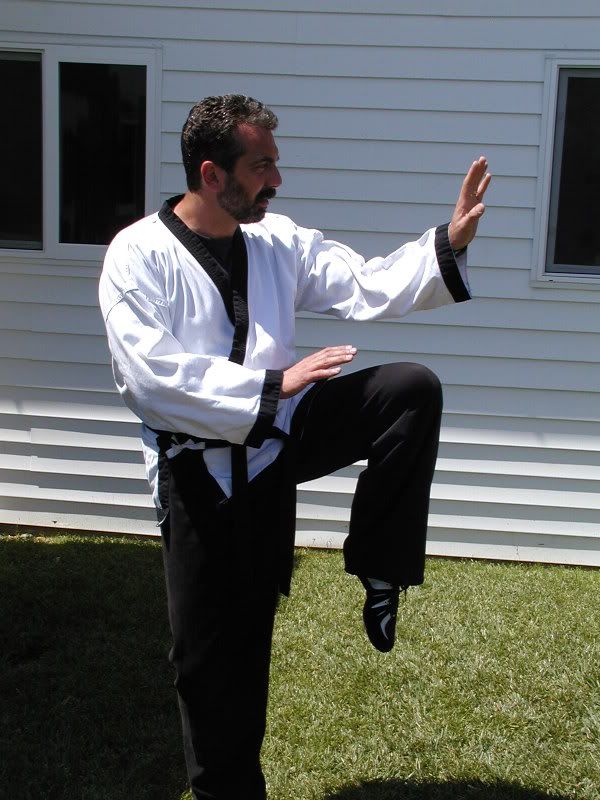 I will probably get myself in trouble again by saying this, but I am continually amazed by the fact that many martial arts classes I have attended or visited seem to teach students a disproportionate use of the feet and legs in self defense.
I will probably get myself in trouble again by saying this, but I am continually amazed by the fact that many martial arts classes I have attended or visited seem to teach students a disproportionate use of the feet and legs in self defense.While it is true that a human being's legs are much larger and stronger than the arms, it is not appropriate in my estimation to leave the hands and arms out of the picture.
Not long ago, I attended a class in WTF Tae Kwon Do. I should stop here and clarify that I have nothing against Tae Kwon Do. I studied it for years and learned great lessons in the process. One of the instructors I respect most is Master Stegall who is a 6th Dan in ITF Tae Kwon Do. I go out of my way to learn from him at every available opportunity. Having cleared that up, I can get back to my story.
I was attending this class and was given the opportunity to do some sparring with one of the instructors. He was a great guy and lightning fast with his feet. It became quickly apparent that my best chances for survival could be found in either running away or getting in close. Since I was all dressed up in my fancy Japanese pajamas (Martial arts uniform) I couldn’t very well run away. So, I took the first opportunity to bridge the distance and move in close. I got my grubby little hands on him and proceeded to put him on the mat. He had kicked the snot out of me in the proceeding 30 seconds, so I thought landing his rump on the mat was the least I could do.
He was very gracious about it all. He got up with a smile and we started again. Each time we clashed, I found my safety zone inside his powerful kicking range. He found his at the extension of his kicking power. He was twenty or so years younger than me and easily twice as fast, but I found that I could still manage to land a kick or two if I chose my opportunities carefully. The problem for him was that he didn’t have any hands. I don’t mean that literally. The man possessed hands; he just didn’t know how to use them effectively. By all rights, he was nothing but lightning fast feet.
Because of this out of balance approach to his training, I was able to take advantage of his weakness. I stayed close. Sure, he could still execute those cool rubber band Tae Kwon Do close up kicks, but they didn’t help him. I was too close and the moment he lifted a foot off the mat, his center of gravity was broken and down he went with a little help from me.
After the sparring match, he and I talked a little. He told me that he focuses on tournament competition and the rules of such things forbid clinching and throwing. As a consequence, his training has consisted of 90% kicking techniques and only 10% hand use. I listened and kept my comments to myself, but I will share them with you now.

The human body has many parts and many potential tools that can be used in self defense. Among these are hands, arms, legs and feet to name only the obvious. The idea of summarily eliminating 50% of your tools from the tool box is foolish in the extreme.
While I understand that some martial styles have been converted from “martial” arts to “sport” arts, it is important for the student to understand the difference. Sport arts are perfectly legitimate for a sporting application in competition. However, they are not entirely adequate for self defense.
To clarify the glaring difference between the two, we must define the words in questions. The word “martial” is defined by Webster’s New World Dictionary as follows: “Of or suitable for war.” By contrast the word “sport” is defined as, “Any activity or experience that gives enjoyment or recreation.” While I enjoy studying, practicing and teaching martial arts, that which I study and teach is “of or suitable for war”.
So, if you’re hunting for a martial arts class to attend, my advice is to determine where your focus will be before you start. The best way to determine this is to be honest with yourself when you look in the mirror and ask, “Why do you want to learn a martial art?’ Your answer will determine whether “sports” instruction or “martial” instruction are right for you. It should be noted that many martial styles have both sports focused and martial focused sub-styles. Tae Kwon Do is just one example. Whichever you chose, be sure to remember the limitations of the instruction you have chosen and for goodness sake make sure you learn the use of your hands.
